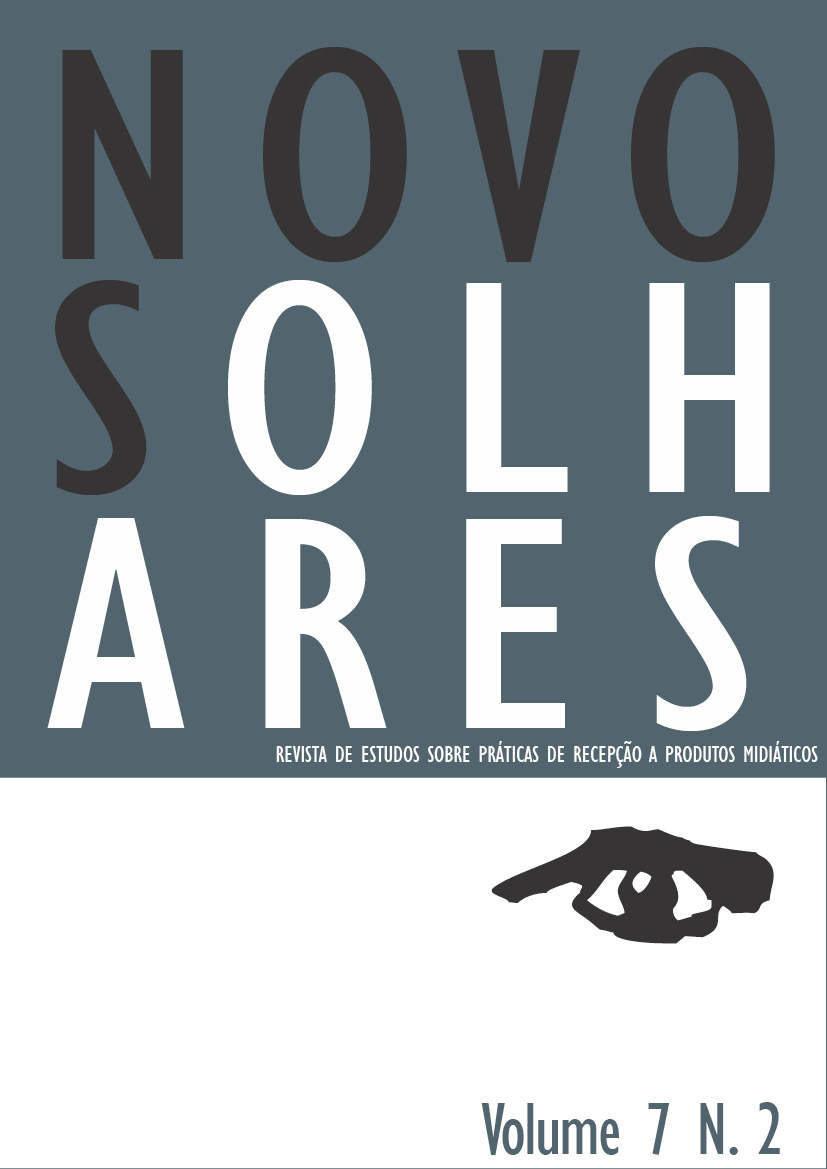The sublimity of data
a critical review of The Glass Room exhibition
DOI:
https://doi.org/10.11606/issn.2238-7714.no.2018.149040Keywords:
Aesthetics, Big data, Consumption, Identity, PrivacyAbstract
This article aims at reflecting on the aesthetic experience provided by The Glass Room exhibition, held in London, which explores how the use of online services can be monitored and reorganized as big data for the production of user behavior profilling. As methodology, we chose the participant observation, carried out November 22, 2017, as well as a theoretical-methodological approach to reflect about the implication of data visualization regarding the aesthetization in the artistic capitalism stage, sharing the sublime, the aesthetics in the construction of digital identities, and the role of records as the modus operandi of the work analyzed. Finally, we argue the data visualization promoted by the exhibition reaches the kantian notion of sublime and analyze the development its greatness for the visitors.
Downloads
References
AGÊNCIA EFE. Facebook, Twitter e Google veem influência da Rússia em eleições nos EUA. G1, São Paulo, 31 out. 2017. Mundo. Disponível em: <https://glo.bo/2A14jEE>. Acesso em: 19 dez. 2017.
AGRA, L. Monstrutivismo: reta e curvas nas vanguardas. São Paulo: Perspectiva, 2010.
ARANTES, P. Re/escrituras da arte contemporânea: história, arquivo e mídia. Porto Alegre: Sulina, 2015.
BEAN, R. How companies say they are using big data. Harvard Business Review, Harvard, 28 abr. 2017. Disponível em: <https://bit.ly/2pGe9aM>. Acesso em: 16 ago. 2018.
CAIRO, A. The functional art: an introduction to information graphics and visualization. San Francisco: New Riders, 2013.
CAMPBELL, C. Eu compro, logo sei que existo: as bases metafísicas do consumo moderno. In: CAMPBELL, C.; BARBOSA, L. (Org.). Cultura, consumo e identidade. Rio de Janeiro: FGV, 2006.
CARISON, R. The psycology of sharing. Contently, [S.l.], 24 fev. 2012. Disponível em: <https://bit.ly/2IJTGsm>. Acesso em: 20 dez. 2017.
CUIDADO com as mídias sociais: seu futuro empregador está de olho. G1, São Paulo, 27 maio 2016. Economia: concursos e emprego. Disponível em: <http://glo.bo/1NRE3Q7>. Acesso em: 18 dez. 2017.
DAVIES, W. The happiness industry: how the government and big business sold us well-being. London: Verso, 2016.
FUCHS, C. New media, web 2.0 and surveillance. Sociology Compass, Hoboken, v. 5, n. 2, p. 134-147, fev. 2011. Disponível em: <https://bit.ly/2pI9nYi>. Acesso em: 28 jan. 2016.
GUMBRETCH, H. U. Pequenas crises: experiência estética nos mundos cotidianos. In: GUIMARÃES, C.; LEAL, B. S.; MENDONÇA, C. C. Comunicação e experiência estética. Belo Horizonte: UFMG, 2006.
KANT, I. Crítica da faculdade do juízo. Rio de Janeiro: Forense Universitária, 1995.
KEYES, D. Walmart is charging different prices online and in-store. Business Insider, New York, 15 nov. 2017. Disponível em: <https://read.bi/2pNiIhv>. Acesso em: 18 dez. 2017.
LIPOVETSKY, G.; SERROY, J. A estetização do mundo: viver na era do capitalismo artista. São Paulo: Companhia das Letras, 2015.
LUPTON, D. Self-tracking modes: reflexive self-monitoring and data practices. SSRN, Amsterdã, 21 ago. 2014. Disponível em: <https://bit.ly/2J8A9Ce>. Acesso em 20 junho 2018.
NEFF, G.; NAFUS, D. Self-tracking. Cambridge: MIT Press, 2016.
NISSENBAUM, H. A contextual approuch to privacy online. Deadalus, Cambridge (MA), v. 140, n. 4, p. 32-48, 2011. Disponível em: <https://bit.ly/2E7DKBH>. Acesso em: 28 jan. 2016.
OLIVEIRA, Í. S. C. S. et al. Explorando conceitos – pesquisa bibliográfica e elaboração de infográfico sobre definições do campo de Design da Informação. InfoDesign, Curitiba, v. 14, n. 3, p. 285-308, 2017.
OUDSHOORN, N. Telecare technologies and the transformation of healthcare. London: Palgrave Macmillan, 2011.
PALO, M. J. A palavra e o imaginário em Alice através do espelho, de Lewis Carroll. Literartes, São Paulo, n. 3, 2014.
PARENTES, J. Como o Netflix usa algoritmos para escolher a sua nova série perfeita. TechTudo, [S.l.], 27 ago. 2017. Downloads. Disponível em <https://glo.bo/2A0UnuC>. Acesso em: 19 dez. 2017.
PEREIRA, M. D. E. S. Éthos em rede: dinâmicas, apropriações e implicações éticas do éthos conectado no Facebook. Dissertação (Mestrado em Comunicação e Práticas de Consumo) – Escola Superior de Propaganda e Marketing, São Paulo, 2016. Disponível em: <https://bit.ly/2PlUJkY>. Acesso em: 12 jan. 2018.
PERES-NETO, L. Ética, comunicação e consumo: apontamentos a partir do estudo da privacidade. In: ENCONTRO DA COMPÓS, 24., 2015, Brasília, DF. Anais... Brasília, DF: Compós, 2015. p. 1-18. Disponível em: <https://bit.ly/2QCOZ6i>. Acesso em: 28 jan. 2016.
RANCIÈRE, J. A partilha do sensível: estética e política. São Paulo: Exo Experimental Org.; Editora 34, 2009.
REBELLO, J; SHUKLA, S. Forget credit rating, your social media posts may decide whether you will get a loan or not. The Economic Times, Mumbai, 13 dez. 2017. Disponível em: <https://bit.ly/2OQPfBq>. Acesso em: 18 dez. 2017.
SBARAI, R. Empresas seguem funcionários nas redes sociais. Veja, São Paulo, 2 jul. 2010. Tecnologia. Disponível em: <https://abr.ai/2QCBx2o>. Acesso em: 18 dez. 2017.
SOLOVE, D. J. ‘I've got nothing to hide’ and other misunderstandings of privacy. San Diego Law Review, San Diego, v. 44, p. 745-772, 2007.
Downloads
Published
Issue
Section
License
Proposta de Aviso de Direito Autoral Creative Commons
1. Proposta de Política para Periódicos de Acesso Livre
Autores que publicam nesta revista concordam com os seguintes termos:
- Autores mantém os direitos autorais e concedem à revista o direito de primeira publicação, com o trabalho simultaneamente licenciado sob a Licença Creative Commons Attribution CC Attribution-NonCommercial-NoDerivatives 4.0, que permite o compartilhamento do trabalho com reconhecimento da autoria e publicação inicial nesta revista.
- Autores têm autorização para assumir contratos adicionais separadamente, para distribuição não-exclusiva da versão do trabalho publicada nesta revista (ex.: publicar em repositório institucional ou como capítulo de livro), com reconhecimento de autoria e publicação inicial nesta revista.
- Autores têm permissão e são estimulados a publicar e distribuir seu trabalho online (ex.: em repositórios institucionais ou na sua página pessoal) a qualquer ponto antes ou durante o processo editorial, já que isso pode gerar alterações produtivas, bem como aumentar o impacto e a citação do trabalho publicado.



